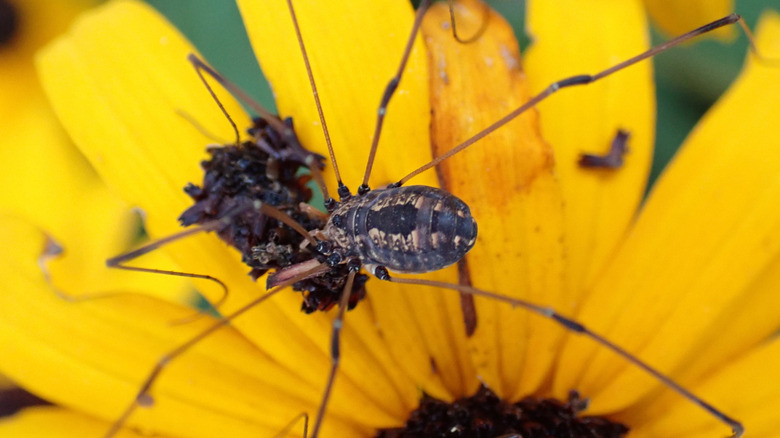The Unexpected Reason Daddy Long Leg 'Spiders' Only Walk On Three Pairs Of Legs
Spiders use their eight legs to walk, but daddy longlegs are different in that they use just six legs to walk — which raises the question of what they use those other appendages for. Well, it turns out the free pair allow daddy longlegs, or Opiliones, to survey and sense the world around them; they're also incredibly articulate, providing the arachnids with the ability to climb and manipulate their food much more easily.
The fact that daddy longlegs aren't actually spiders is one of those things that most people sort of know is true but aren't sure why. Making things more complicated is the fact that different countries use the term "daddy longlegs" to refer to different creatures (yes, shockingly, the term "daddy longlegs" isn't actually a scientific classification). In the United Kingdom, the crane fly and other long-legged flies are known by the term, but in the United States, a daddy longlegs is typically thought to be either a cellar spider (one of the common spiders in Massachusetts) or a member of the Opiliones order, otherwise known as harvestmen.
There are around 6,660 known species of Opiliones, and while they are all arachnids (the group that includes spiders, scorpions, and other arthropods), Opiliones are not actually spiders (or creatures belonging to the Araneae order). Though they appear to be very similar to spiders, these particular invertebrates have just one body section as opposed to the two you find on spiders. They also lack the eight eyes of their arachnid cousins, and instead have just two which sit in the middle of their cephalothorax (the conjoined head and thorax section of their bodies). You won't find any silk or venom in Opiliones, either, all of which makes them entirely distinct from true spiders — as do their legs, which are significantly different from those of spiders in important ways.
Daddy longlegs use their long legs to sense the world around them
Despite all the differences between "true" spiders (of the order Araneae) and Opiliones, we continue to think of these eight-legged arachnids as spiders in the traditional sense. That's understandable considering their physical similarities, but all it takes to really see the difference between these creatures is looking closely at how Opiliones (or "daddy longlegs") walk using just three pairs of legs.
On harvestmen, the second pair of legs from the front are actually known as pedipalps, which refers to appendages used for multiple purposes, from sensing the environment to handling food and, yes, in some cases walking. It's not just Opiliones that have pedipalps, though. Different species of arachnids feature different structures on their pedipalps. Amblypygi have spines, Scorpiones have chelae or pincer-like claws, and Amblypygi have adhesive pads. Harvestmen have many different types of structures on their pedipalps, with some showcasing complex glandular setae which emit a type of glue to incapacitate prey.
One of the most interesting pedipalp morphologies within the Opiliones order, however, involves small growths which resemble hairs and work as sensory organs. This explains why some daddy longlegs species effectively walk on just three pairs of legs, with the longest pair remaining free. Opiliones with sensory hairs on their longest legs will wave these appendages around like the arachnid version of canes, essentially using them as antennae or feelers. This is partly due to the fact that the two eyes of Opiliones are fairly weak, meaning the harvestmen need extra help to navigate the world. A 2024 study published in Current Biology did find that Opiliones actually appeared to have two pairs of vestigial eyes that never fully form, but while these may help with light detection, they don't provide harvestmen with any better vision, making the sensory pedipalps all the more necessary.
Some daddy longlegs have super articulate legs
Opiliones' pedipalps aren't just used for sensing the surrounding environment. The legs of these arachnids are divided into many different sections called tarsomeres, each of which allows for precise articulation of the appendage itself. Recent research has now shed light on how Opiliones came to evolve these remarkable limbs and has shown how the longest legs, or pedipalps, are typically the most articulate of all the legs.
A 2021 study published in Proceedings of the Royal Society B looked at the species Phalangium opilio, which is thought to be the most widespread harvestman species. The study found that while each leg had tarsomeres, their longest legs, or pedipalps, had the most, with some displaying 80 tarsomeres and others more than 100. As the researchers noted, this essentially makes the end segment of the legs prehensile, allowing the arachnids to wrap their legs around objects and climb more easily, perhaps even aiding the creatures in escaping predators that eat daddy longlegs. These super-articulate legs are also used in courtship and male-on-male combat, which makes harvestmen unique; while other arthropods have tarsomeres, the daddy longlegs are the only creatures that appear to use them for such a wide range of actions.
The study actually represented the first time the genome of a daddy longlegs had been sequenced, revealing the evolutionary processes that form the pedipalps in the Phalangium species. Clearly, these processes are advantageous — after all, the harvestmen species with the most tarsomeres on their pedipalps is also the most widespread. So, if you do happen to see a daddy longlegs walking on only three pairs of legs, you'll not only immediately recognize it as not a "true" spider, but you'll know what it's doing with that extra-long pair of legs.


